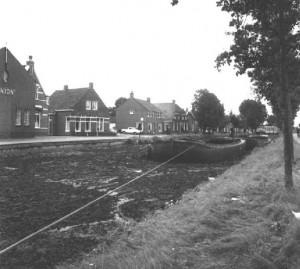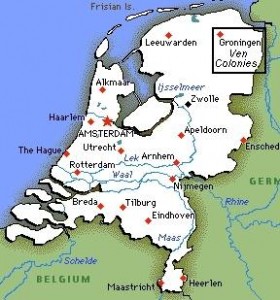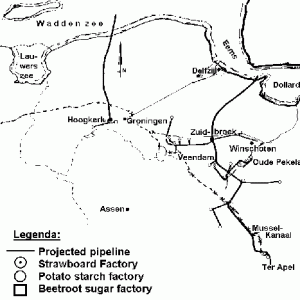Introduction
In the north of the Netherlands, in the province of Groningen, is an area called ‘De Veenkoloniën’ (The Ven Colonies or Peat Colonies). This area once provided the main energy source of the Dutch Golden Age: peat. During the period between the beginning of 16th trough the start of the 20th century the peat moors were drained and cut away. In the second half of the 19th century the peat in the Veenkoloniën was almost gone1. What remained was a unique landscape dominated by huge fields and straight canals. This landscape formed the foundation for the agricultural industry that emerged in the second half of the 19th century, with potato starch and strawboard as their main products.
The emergence of the agricultural industry in the Groninger Veenkoloniën caused a quite serious problem: one of the worst episodes of industrial water pollution in the Netherlands. This gave the Veenkoloniën the negative image of a region with filthy and stinking canals, being the concern of the industry, government and population for more than a century. The water pollution in Groningen was very noticable and Anthony Winkler Prins, the famous minister, encyclopedist and publicist from the Veenkoloniën, gave a vivid description of the condition of the canals in a regional news paper in 1872:
A nauseating stench rose from the canals. The watercourses were littered with dead fish floating on their backs, because the water was so filthy that it had become useless for animals and humans alike, even the pumps produce nothing but spoilt liquid2.
The problem was only finally solved in the 1980s. This is not to say that there have been no attempts to solve the problem of water pollution during the previous century3.
Government concerns
Around 1850 local and national authorities where alarmed by what they perceived as a sharp increase in water pollution in this region. In 1859 Doctor Ali Cohen was asked by the provincial authorities to start a survey into the causes and effects of the water pollution. The report that resulted from this survey was the basis for the very first legal actions to be taken to counter the negative effects of the water pollution in the Veenkoloniën. Ten years after his first report, Cohen published a second report for the provincial authorities of Groningen. This was the first of four additional reports that surveyed the possibilities of purification of the wastewater of potato starch and strawboard factories. These reports have been highly influential during most of the 20th century4.
The reports of Cohen and his contemporaries make it clear that there was a serious concern about the possible health effects on the local population. According to 19th century theories of disease and hygiene the rotting waste products of the industries in the Veenkoloniën would certainly produce harmful microorganisms. This concern was shared by the Health Authorities for the province of Groningen. On several occasions they urged the provincial and local authorities to take measures to deal with the water pollution. But the industry in the Veenkoloniën was not prepared to invest in techniques for cleaning their wastewater. The factories were more interested in that part of the wastewater what they really called ‘waste’. In their opinion waste was something that was useful for other purposes and could be extracted in a financially sound way. Around 1870 the industry realised that fortunes worth of protein and minerals were lost with dumping their wastewater unpurified. These proteins and minerals could be useful as feed or fertiliser5.
Experiments
At the start of the 20th century Dr B. Sjollema, in co-operation with manufacturer Meijer conducted some experiments to extract protein from the wastewater of potato starch factories. These experiments were not successful because of the fact that extraction of protein from wastewater was more difficult and more expensive than expected. The experiments were terminated in 1916 after the refusal of the government to subsidise these experiments. This refusal almost caused the bankruptcy of potato starch factory ‘Oranje’ where the experiments had been carried out.

Foam on polluted canal. (Photo: Collection
Veenkoloniaal Museum Veendam)
In 1908 the government appointed a commission dedicated to solve the water pollution caused by strawboard and potatostarch factories. This commission also failed to solve the problem of water pollution in the Veenkoloniën. Their report and recommendations disappeared in a desk drawer and were never used. Economic interests of the industry in the Veenkoloniën were considered to be more important than clean water. The inglorious end of this report was a foreshadowing of the coming period6.
During the years between the two World Wars there was little interest in solving the wastewater problem in the Groninger Veenkoloniën. But there was at least one hope. In 1919 the ‘Co-operatief Aardappelmeel Verkoopbureau’ (Co-operative potatostarch tradingbureau), AVB for short, was founded. Soon after its foundation it opened a laboratory. The purpose of this laboratory was to analyse and control the quality of AVB’s products. After several years the AVB laboratory started with research into possible reduction of the amount of water used during the production process. They also developed new techniques to extract protein from wastewater7.
The research and experiments were so successful that in 1936 the government decided to subsidise AVB’s research. Although government subsidy stopped in 1940, research continued during the war and laid the foundation for developments after the war.
The sewer pipeline
After World War II was over, there was not much time and money for experiments. The first objective of the industry was to repair the damage caused by the war and restart production. When the reconstruction period was over AVB opened a new laboratory that was fully dedicated to research. This laboratory played a very important role in solving the wastewater problem of the Veenkoloniën. But it was not just this laboratory that studied the wastewater problem.
In the early years of the 1950’s the ‘Rijksinstituut voor de Zuivering van Afvalwater’ (National Institute for the Purification of Wastewater) launched a new idea for solving the wastewater problem of the Groninger Veenkoloniën. Their idea was to construct of a pipeline to the Eems-Dollard estuary to dump the wastewater here. The further elaboration upon this idea resulted in the presentation of a concrete plan in 1960. The original plan was the construction of a pipeline with three branches that should carry all wastewater produced by the potato starch and strawboard factories to the Waddenzee8.
Water pollution law
However, this plan was never carried out as it was originally conceived. In the years that followed on the presentation of the plan, protests from the population and the emerging environmental movement increased. Even the government started to question its own idea.
In 1969 the Dutch government announced a new law on water pollution. The core idea of this law was the adagio ‘the polluter pays’. It gave surface water supervisors the opportunity to impose levies on waterpolluters. This proved to be an effective instrument to force the purification of industrial wastewater by the industry. The new law was not the most important concern of the strawboard industry. This branch of industry was mainly pre-occupied with structural difficulties. By the time the new law came into effect, most of the strawboard factory’s in the Veenkoloniën were already closed down. The remaining factories changed to less polluting raw material as for example recycled paper.
The new law caused some serious problems for the potato starch industry. The investments needed for purifying their wastewater were almost an unbearable burden for the two potatostarch producing companies AVEBE (Former AVB) and Koninklijke Scholten-Honing (KSH). The only solution seemed to be the wastewater pipeline to the Waddenzee. The government however, reduced the capacity of this pipeline. This meant that not all wastewater could be transported to the Waddenzee. Apart from this, the government announced a plan in 1973 to impose high levies on dumping unpurified water. This combination of higher taxes and a smaller capacity of the wastewater pipeline forced the potato starch industry into purification of most of their wastewater, although this seemed an almost impossible task to be carried out by the company’s involved. Both the investments in purification technology and the high environmental taxes went far beyond the financial means of the combined companies9.
Apart from these problems, the deep economic recession that started in 1973 put both AVEBE and KSH in a delicate financial position. This position was so bad that KSH did not survive a failing glucose adventure in Great Britain. KSH had bought and reconstructed a huge factory for extracting glucose from corn. This operation became a financial disaster. In the meantime the Dutch government had raised the levies on dumping unpurified wastewater to an almost unrealistic height. This combination formed the direct cause for the bankruptcy of KSH in the autumn of 1977.
Government pressure and reorganisation
But there was still some hope. Two of the involved government departments in the KSH-drama, the Department of the Interior and the Department of Finance managed to change the bankruptcy into a suspension of payment. Under pressure of the Department of Agriculture KSH consecutively received enough financial aid to survive until the spring of 1978. This aid was provided to create sufficient time for negotiations between AVEBE and KSH about a take-over of KSH’s starch activities. The Department of Agriculture had several other reasons for providing aid to KSH. In the previous decades AVEBE had received considerable financial aid from this department to finance their research into techniques for purifying their wastewater. The choice to support AVEBE instead of KSH had been political one. AVEBE is a co-operative company owned by many potato-farmers based in the Veenkoloniën. This made AVEBE, in contrast to KSH, a typical company from the Veenkoloniën. In the second half of the 1970s AVEBE was the most important employer in the Veenkoloniën, employing more than three thousand people and hundreds of farmers produced potato’s for the company. The bankruptcy of AVEBE would have caused massive unemployment in the Veenkoloniën, which was politically unacceptable in the economic weak province of Groningen. Afraid to loose their influence and electorate in Groningen the political parties involved chose to support AVEBE.
The take-over of the KSH’s starch activity by AVEBE was an important step in solving the water pollution in the Veenkoloniën. The take-over was heavily subsidised by the regional and national government and provided several political and environmental advantages. First of all thousands of jobs were saved. Secondly the whole Dutch potato starch industry was concentrated into one company that could be controlled better by the government. This made it possible to impose more effective measures on the potatostarch industry to purify their wastewater. The main objective of the reorganisation of AVEBE, that followed the take-over of KSH, was the reduction and complete purification of wastewater. This reorganisation was successfully concluded in middle of the 1980’s10.
Conclusion
From the start of the establishment of agricultural industries in the Veenkoloniën, water pollution has been a serious problem. The authorities were concerned about the possible health risks, but the industry was even more concerned about the loss of the ‘real waste’ in the disposed wastewater. For decades both Government and industry tried to put an end to the water pollution, but all efforts failed because technology to purify the wastewater in an economically sound way was not available. This nourished the idea that water pollution was part of the process of industrialisation and the price that people had to pay for their prosperity.
After World War II this attitude withered away under pressure of the rising environmental awareness. The government realised that the water pollution in the Veenkoloniën was not longer acceptable for the population. With new laws, high levies on disposing unpurified water into watercourses and a massive reorganisation of the industries involved, the government forced the industry in the Veenkoloniën to solve their wastewater problem. The same government also provided financial aid needed for the research and reorganisation to bring an end to the water pollution. This policy proved highly successful and by the middle of the 1980s the problem of the water pollution in the Groninger Veenkoloniën had become a thing of the past.
Read the expanded published version of this essay: Jan Oosthoek, “The stench of prosperity. Water Pollution in the Northern Netherlands, 1850-1980“, in: Geneviève Massard-Guilbaud and Christophe Bernhardt (eds.), The Modern Demon. Pollution in Urban and Industrial European Societies (Clermont-Ferrand, 2002), pp. 179-194.
Please quote from this book chapter rather than the essay on this website.
Notes
1Jan W. de Zeeuw, “Peat and the Dutch Golden Age. The Historical Meaning of energy-attainability”,A.A.G. Bijdragen, 21, 1978.
2Anthony Winkler Prins, “Het Vuile Fabriekswater”, Veendammer Courant, 19 November 1972. Translation: JO.
3Jan Oosthoek, “The stench of prosperity. Water Pollution in the Northern Netherlands, 1850-1980”, in: Geneviève Massard-Guilbaud and Christophe Bernhardt (eds.), The Modern Demon. Pollution in Urban and Industrial European Societies (Clermont-Ferrand, 2002), pp. 179-194.
4L. Ali Cohen, “Waterbederf ten gevolge van aardappelmeel fabricage. De naaste oorzaken darvan en de middelen daartegenaan te wenden. Derde rapport aan de Staten van de Provincie Groningen”,Nederlandsch Tijdschrift voor Geneeskunde, 1874, pp. 496-503.
5Ernst Homburg, ‘Schrikbeeld van Scheikundigen Aard: Chemische industrie, chemische wetenschap and het milieu, 1800-1875’, Tijdschrift voor Geschidenis, Vol. 109. 1994, pp. 439-466.
6Oosthoek, Stench of Prosperity, pp. 184-186.
7Annual Report AVEBE, 1928-1929; Vertrouwelijke Rapporten inzake fabricage van veevoeder uit aardappelen, 1936-1937, Archives AVEBE, Rijks Archief Groningen.
8C. Winkler, ‘Maatregelen tegen de waterverontreiniging in the provincie Groningen’, Water, Bodem, Lucht, Vol 1, 1961, pp. 17-19.
9M. Dendermonde, Hoe wij het rooiden. De Veenkoloniale aardappelboer en zijn industrie, Veendam, 1979, pp. 269-270.
10See for more detail: Oosthoek, Stench of Prosperity, pp. 190-193.
Web resources


Recent Comments